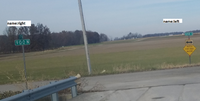Key:name:left
 |
| Description |
|---|
| For way objects, names can differ by side of the object. |
| Group: names |
| Used on these elements |
| Useful combination |
|
| Status: de facto |
| Tools for this tag |
|
This key indicates the name of a linear object on its left side, as opposed to its right side. Typically, this applies to a road or waterway that forms a boundary.[1]
How to tag
Use the name:left=* and name:right=* tags to name both sides separately (using the direction of the way to determine left and right). The name=* tag can still include both names in order to support different tools.
For example, Leopold Luypaertstraat / Borghtstraat![]() Leopold Luypaertstraat / Borghtstraat is tagged:
Leopold Luypaertstraat / Borghtstraat is tagged:
name:left=Leopold Luypaertstraatname:right=Borghtstraatname=Leopold Luypaertstraat / Borghtstraat
Multilingual names
The key can also be combined with the language suffix name:left:xx=* with xx being the ISO code of the language. See: Multilingual names.
For example, Komenstraat - Chemin des Quatre Rois![]() Komenstraat - Chemin des Quatre Rois is tagged:
Komenstraat - Chemin des Quatre Rois is tagged:
name:left:fr=Chemin des Quatre Roisname:left:nl=Vier Koningenweg
Direction of travel
name:left=* and name:right=* were originally designed for renderers, which would offset a label to the left or right of a line. However, routers need to associate each name with a direction of travel, so that the user will see the correct name when traveling in one direction along the roadway. The meaning of name:left=* and name:right=* is not as obvious to a router, because the driving side differs from one region to another and based on driving_side=*. To accommodate this use case, name:left=* and name:right=* are sometimes paired with name:forward=* and name:backward=*, by analogy with many other keys like maxspeed:forward=*, turn:lanes:forward=*, and ref:forward=* that are well supported by routers. [1] (The Valhalla-based Mapbox Directions API supports name:forward=* and name:backward=*.)
Examples
- A street is on the boundary between Belgium and the Netherlands. Belgium gives it the name "Amsterdamsestraat" and the Netherlands gives it the name "Brusselsestraat".
- In Italy, this street is known as Via Nebrodi in San Giovanni la Punta but Via Maria Auxilium in Viagrande. To ensure that the street always remains associated with both administrative areas, it is fully connected to the way shared by both boundary relations.
- In New York City, this street is Ruby Street in Brooklyn on one side and 75th Street in Queens on the other side,[2] which is not to be confused with 75th Street in Brooklyn. To keep a geocoder from returning the wrong 75th Street when looking for the one in Brooklyn, the Brooklyn–Queens boundary should line up exactly with the street.
- In Hamilton County, Ohio, the corporation line between Cincinnati and Norwood legally follows the centerline of two intersecting streets that have different names on either side of the street. This street is Tennessee Avenue in Cincinnati and Ross Avenue in Norwood, while this street is Rhode Island Avenue in Cincinnati and Section Avenue in Norwood. But Section also refers to a different street in Cincinnati and a third neighboring municipality, Amberley Village.[3]
Notes and references
- ↑ Historically,
name:left=*andname:right=*were also added toboundary=administrativeways. However, this usage has been replaced byboundary=administrativerelations. Nowadays, you can safely removename:left=*andname:right=*from a way that is already a member of aboundary=administrativerelation. - ↑ “New York City Administrative Code”. Cincinnati: American Legal Publishing. §2-202. “…thence easterly along such prolongation and along the center line of One hundred fifty-seventh avenue to the center line of Ruby street; thence northerly along the center line of Ruby street to the center line of One hundred fifty-fifth avenue; thence easterly along the center line of One hundred fifty-fifth avenue…”
- ↑ Hunter, Ginny (September 20, 1984). “Town & country: Getting prepared for any disaster; Street sense; Zoo view; Loss for parks”. The Cincinnati Post. p. 11B.